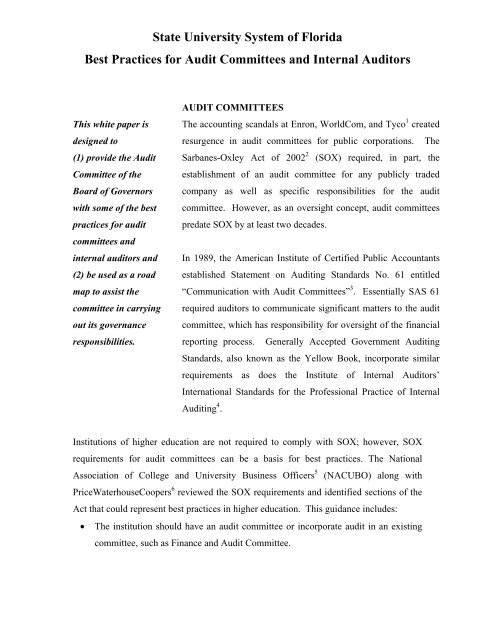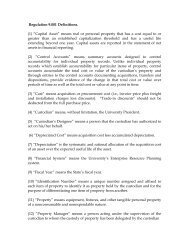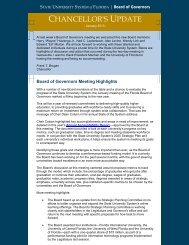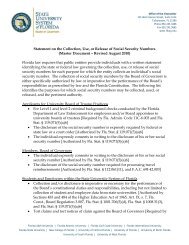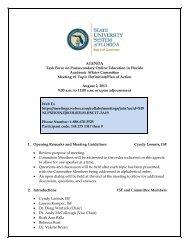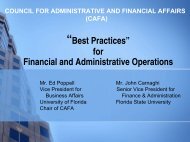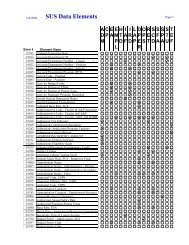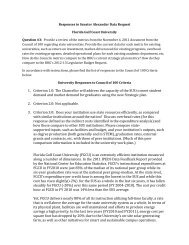Best Practices for Higher Education Audit Committees
Best Practices for Higher Education Audit Committees
Best Practices for Higher Education Audit Committees
You also want an ePaper? Increase the reach of your titles
YUMPU automatically turns print PDFs into web optimized ePapers that Google loves.
State University System of Florida<br />
<strong>Best</strong> <strong>Practices</strong> <strong>for</strong> <strong>Audit</strong> <strong>Committees</strong> and Internal <strong>Audit</strong>ors<br />
This white paper is<br />
designed to<br />
(1) provide the <strong>Audit</strong><br />
Committee of the<br />
Board of Governors<br />
with some of the best<br />
practices <strong>for</strong> audit<br />
committees and<br />
internal auditors and<br />
(2) be used as a road<br />
map to assist the<br />
committee in carrying<br />
out its governance<br />
responsibilities.<br />
AUDIT COMMITTEES<br />
The accounting scandals at Enron, WorldCom, and Tyco 1 created<br />
resurgence in audit committees <strong>for</strong> public corporations. The<br />
Sarbanes-Oxley Act of 2002 2 (SOX) required, in part, the<br />
establishment of an audit committee <strong>for</strong> any publicly traded<br />
company as well as specific responsibilities <strong>for</strong> the audit<br />
committee. However, as an oversight concept, audit committees<br />
predate SOX by at least two decades.<br />
In 1989, the American Institute of Certified Public Accountants<br />
established Statement on <strong>Audit</strong>ing Standards No. 61 entitled<br />
“Communication with <strong>Audit</strong> <strong>Committees</strong>” 3 . Essentially SAS 61<br />
required auditors to communicate significant matters to the audit<br />
committee, which has responsibility <strong>for</strong> oversight of the financial<br />
reporting process. Generally Accepted Government <strong>Audit</strong>ing<br />
Standards, also known as the Yellow Book, incorporate similar<br />
requirements as does the Institute of Internal <strong>Audit</strong>ors’<br />
International Standards <strong>for</strong> the Professional Practice of Internal<br />
<strong>Audit</strong>ing 4 .<br />
Institutions of higher education are not required to comply with SOX; however, SOX<br />
requirements <strong>for</strong> audit committees can be a basis <strong>for</strong> best practices. The National<br />
Association of College and University Business Officers 5 (NACUBO) along with<br />
PriceWaterhouseCoopers 6 reviewed the SOX requirements and identified sections of the<br />
Act that could represent best practices in higher education. This guidance includes:<br />
• The institution should have an audit committee or incorporate audit in an existing<br />
committee, such as Finance and <strong>Audit</strong> Committee.
• The audit committee should have a charter and the necessary authority to carry<br />
out its duties.<br />
• The audit committee should include at least one<br />
financial expert. Universities should consider<br />
rotating the financial expert and planning <strong>for</strong> the NACUBO and<br />
process and cost of recruiting, training, and PriceWaterhouseCoopers<br />
retaining financial expertise.<br />
gave these guidelines <strong>for</strong><br />
• Institutions with internal audit departments should higher education audit<br />
consider using them to periodically report on committees based on SOX.<br />
internal controls to the audit committee in<br />
addition to reporting to management.<br />
• The audit committee should ensure a process exists <strong>for</strong> receiving confidential<br />
complaints and reviewing the nature and disposition of reported matters.<br />
• The audit committee should consider periodic inquiries of executives on the<br />
adequacy of financial controls.<br />
• Executive incentives related to financial results should be disclosed to the audit<br />
committee.<br />
• The audit committee should be aware of and review policies on ownership<br />
interests in related ventures or start-ups. Existing conflict of interest policies can<br />
be leveraged and should be reviewed with the audit committee.<br />
• The audit committee should review the code of ethics <strong>for</strong> senior financial officers<br />
and periodically review how compliance is assured.<br />
• The audit committee should review the per<strong>for</strong>mance of the external auditor<br />
annually and consider rotating the external audit among different audit firms. For<br />
the SUS, external audits are per<strong>for</strong>med by the Florida <strong>Audit</strong>or General, so rotation<br />
of external audit firms is not applicable. However, rotation of external auditors<br />
<strong>for</strong> the university’s direct support organizations and athletics program, if<br />
applicable, is a consideration. Also, the audit committee should approve, in<br />
advance, any non-audit work per<strong>for</strong>med by external auditors.<br />
2
The Institute of Internal <strong>Audit</strong>ors (IIA), an international professional organization <strong>for</strong><br />
internal auditors, provides a global perspective on audit committee best practices. The<br />
IIA lists ten key areas of responsibility <strong>for</strong> audit committees, which can be incorporated<br />
into the audit committee charter 7 :<br />
1. Financial statements. The audit committee should understand financial<br />
statements and review significant accounting and reporting issues. The<br />
committee should also review the results of external audits, including financial<br />
statements, federal awards, and operational audits at SUS institutions. The<br />
<strong>Audit</strong>or General (AG) per<strong>for</strong>ms financial and operational audits of the<br />
universities as required by Florida Statutes, using Governmental <strong>Audit</strong>ing<br />
Standards. The audit committee should consider meeting with the AG staff each<br />
year about the scope and time frame of the engagement. Also, the BOG may<br />
need to determine if direct support and affiliated organizations’ audited financial<br />
statements should follow the requirements of the Governmental Accounting<br />
Standards Board as the universities do.<br />
2. Risk management and internal control. The audit committee should discuss<br />
risk assessment and risk management policies with management and the chief<br />
audit executive. The committee should consider the effectiveness of the<br />
university’s internal control system and review any report on significant audit<br />
findings and recommendations, including management’s responses and<br />
corrective action.<br />
3. Compliance and ethics. The audit committee should review the effectiveness of<br />
the system <strong>for</strong> monitoring compliance with laws and regulations. Procedures<br />
should exist <strong>for</strong> receiving complaints and per<strong>for</strong>ming investigations. Also, the<br />
committee should ensure that evolving expectations are met and the university’s<br />
reputation is protected.<br />
4. Oversight of internal auditing. The audit committee should review the internal<br />
audit charter, risk assessments, work plans, activities, staffing, organizational<br />
structure, and reporting lines. The committee should review the effectiveness of<br />
the internal auditing function and review and concur with the appointment and<br />
3
dismissal of the chief audit executive. Regular meetings should be held with the<br />
chief audit executive to discuss sensitive or confidential matters privately.<br />
(While the Florida Sunshine Law does not allow private business-related<br />
conversations with more than one audit committee member, audit committee<br />
members can, and should, hold individual private conversations with the chief<br />
audit executive as needed to address sensitive or confidential matters.)<br />
The IIA Research Foundation sponsored a document titled “20 Questions<br />
Directors Should Ask About Internal <strong>Audit</strong>” 8 authored by John Fraser, CA, CIA,<br />
CISA and Lindsay Hugh, FCA, CIP, which addresses issues such as:<br />
• Internal <strong>Audit</strong> role and mandate<br />
• Internal <strong>Audit</strong> relationships<br />
• Internal <strong>Audit</strong> resources<br />
• Internal <strong>Audit</strong> process<br />
• Closing questions<br />
• <strong>Audit</strong> Committee assessment<br />
Each question has a brief discussion and, where appropriate, practice<br />
recommendations. The questions and recommendations contained in this<br />
publication are very helpful in the evaluation of the effectiveness of internal audit<br />
functions and should be reviewed by audit committee members and university<br />
management.<br />
5. Relationship with external auditors. The audit committee should impart<br />
guidance on how to establish and maintain the relationship with the external<br />
auditors.<br />
6. Resources. The audit committee should use sufficient resources to effectively<br />
carry out their responsibilities.<br />
7. Committee composition. The audit committee should have membership with a<br />
breadth of skill and expertise to assure success.<br />
4
8. Training. Plans should be made to obtain requisite knowledge.<br />
9. Meetings. Suggestions should be made to improve meeting effectiveness, through<br />
agendas, targeted advance materials, and active participation.<br />
10. Charter and evaluation. Members should recommend methods <strong>for</strong> selfassessing<br />
the adequacy of the charter and the effectiveness of the committee’s<br />
per<strong>for</strong>mance.<br />
Underlying these responsibilities is the all-encompassing concept of governance. Sy<br />
Sternberg, CEO of New York Life Insurance Co., put it this way: “Proper corporate<br />
governance is the cornerstone of all internal control systems. Governance means<br />
establishing, communicating, and en<strong>for</strong>cing clear accountabilities and responsibilities.<br />
And, as far as I’m concerned, the three most critical roles in governance belong to the<br />
internal auditor, the board’s audit committee, and the CEO. All three must be fully<br />
engaged. All three must take leadership roles. And all three must work closely<br />
together.”<br />
INTERNAL AUDITORS<br />
An effective internal auditing activity provides assurance that internal controls are<br />
sufficient to mitigate risks, that governance processes are adequate, and that<br />
organizational goals and objectives are met.<br />
The IIA 9 outlines best practices of the internal auditing activity as follows:<br />
• Organizational independence and reporting structure. The audit activity<br />
should have sufficient independence to conduct work without interference. <strong>Best</strong><br />
practice has the chief audit executive reporting functionally to the audit<br />
committee with administrative reporting to the university president. The<br />
publication “20 Questions Directors Should Ask about Internal <strong>Audit</strong>” further<br />
clarifies these reporting relationships.<br />
5
• Unrestricted access. Internal auditors should have complete and unrestricted<br />
access to employees, property, and records of the university. If the scope of the<br />
internal audit activity extends to the direct support and affiliated organizations of<br />
the university, this access should be expanded to the records and employees of<br />
those organizations as well,<br />
• <strong>Audit</strong> charter. The purpose, mission, and authority of internal auditing should be<br />
established in a <strong>for</strong>mal charter. The charter should address independence, duties,<br />
responsibilities, and professional standards and should be approved by the audit<br />
committee.<br />
• Professional audit standards. Standards provide a framework to promote quality<br />
audit work. The IIA’s International Standards <strong>for</strong> the Professional Practice of<br />
Internal <strong>Audit</strong>ing 4 and Code of Ethics are generally accepted and give internal<br />
auditors an approach that provides a systematic, objective, and evidentiary basis<br />
<strong>for</strong> their work.<br />
• Training and quality assessment. To stay abreast of emerging issues facing<br />
universities and the internal audit profession, internal auditors should participate<br />
in continuing education programs. Also, professional standards require an<br />
external quality assessment of internal audit activity every five years as well as<br />
ongoing self-assessments.<br />
• Prioritization, a risk-based approach. The internal auditing function must<br />
assess organizational risks and operational changes <strong>for</strong> the most effective use of<br />
internal audit resources. This risk-based approach should also be applied to the<br />
development of the internal audit work plan as well as to each individual audit.<br />
• <strong>Audit</strong> reports and follow-up. The results of audits are communicated through<br />
<strong>for</strong>mal audit reports that should be distributed to appropriate levels of<br />
management. The audit reports may also be distributed to the audit committee.<br />
Internal auditing should follow up on its observations and recommendations to<br />
ensure management’s action plans were effectively implemented. Results of the<br />
follow-up may be conveyed to the audit committee.<br />
• Advisory services and investigations. In addition to audits, internal auditing<br />
should provide advisory services to management and investigate complaints or<br />
6
allegations of fraud. Advisory services are generally a more in<strong>for</strong>mal approach to<br />
improving controls and operations. Investigations should be handled in a<br />
confidential manner with communication to the audit committee as needed to<br />
keep them in<strong>for</strong>med and up-to-date on issues facing the university.<br />
SUMMARY<br />
The Board of Governors has significant oversight responsibilities <strong>for</strong> Florida’s higher<br />
education system. The BOG audit committee in collaboration with the universities’ audit<br />
committees and their respective internal audit executives can ensure that processes are in<br />
place to meet those responsibilities. This white paper is the roadmap of best practices to<br />
achieve effective governance at the institutions related to audit committees and internal<br />
audit.<br />
7
Footnotes<br />
1 Forbes.com “The Corporate Scandal Sheet” P. Patsuris, August 26, 2002, lists recent<br />
accounting scandals http://www.<strong>for</strong>bes.com/2002/07/25/accountingtracker.html<br />
2 The Sarbanes-Oxley Act of 2002 http://www.sec.gov/about/laws/soa2002.pdf<br />
3 American Institute of Certified Public Accountants Statement on <strong>Audit</strong>ing Standards<br />
No. 61 Communication with <strong>Audit</strong> <strong>Committees</strong><br />
http://www.aicpa.org/download/members/div/auditstd/AU-00380.PDF<br />
4 Institute of Internal <strong>Audit</strong>ors International Standards <strong>for</strong> the Professional Practice of<br />
Internal <strong>Audit</strong>ing http://www.theiia.org/guidance/<br />
5<br />
NACUBO Checklist <strong>for</strong> <strong>Higher</strong> <strong>Education</strong> (NACUBO recommendations regarding<br />
Sarbanes-Oxley Act of 2002)<br />
http://www.nacubo.org/documents/business_topics/SOXChecklist3.7112003.doc<br />
6<br />
NACUBO and PriceWaterhouseCoopers “Sarbanes Summit: Taking the Right Path”<br />
http://www.nacubo.org/x8028.xml?s=x40<br />
7 Institute of Internal <strong>Audit</strong>ors and PriceWaterhouseCoopers publication: <strong>Audit</strong><br />
Committee Effectiveness –What Works <strong>Best</strong> August 9, 2005 (available <strong>for</strong> purchase)<br />
http://www.theiia.org/theiia/newsroom/news-releases/?C=226<br />
8<br />
Institute of Internal <strong>Audit</strong>ors “20 Questions Directors Should Ask about Internal <strong>Audit</strong>”<br />
August 2004 (available <strong>for</strong> purchase)<br />
http://www.theiia.org/bookstore.cfm?fuseaction=product_detail&order_num=519<br />
9<br />
The Institute of Internal <strong>Audit</strong>ors has two publications relevant to audit committees and<br />
internal auditing, especially in the public sector. “Role of <strong>Audit</strong>ing in Public Sector<br />
Governance” http://www.theiia.org/download.cfm?file=3512 and “The <strong>Audit</strong><br />
Committee: Purpose, Process, Professionalism” http://xrl.us/uiw3<br />
Other Reading<br />
American Institute of Certified Public Accountants, <strong>Audit</strong> Committee Toolkit <strong>for</strong> not-<strong>for</strong>profits<br />
http://www.aicpa.org/Audcommctr/toolkitsnpo/homepage.htm<br />
Association of Governing Boards, Effective <strong>Committees</strong>: The <strong>Audit</strong> Committee<br />
http://www.agb.org/wmspage.cfm?parm1=547 (available <strong>for</strong> purchase)<br />
State of Tennessee <strong>Audit</strong> Committee Act http://comptroller.state.tn.us/Attachment_A.pdf<br />
8
State Universities <strong>Audit</strong> Council<br />
Florida Agricultural and Mechanical University<br />
Division of Compliance & <strong>Audit</strong><br />
Rufus R. Little, III, Vice President<br />
Florida Atlantic University<br />
Office of the Inspector General<br />
Morley Barnett, Inspector General<br />
Florida Gulf Coast University<br />
Office of Internal <strong>Audit</strong><br />
Carol Slade, Director<br />
Florida International University<br />
Office of Internal <strong>Audit</strong><br />
Ted Guba, <strong>Audit</strong> Director<br />
Florida State University<br />
Office of <strong>Audit</strong> Services<br />
David Coury, Chief <strong>Audit</strong> Officer<br />
University of Central Florida<br />
University <strong>Audit</strong><br />
Amy S. Voelker, Director<br />
University of Florida<br />
Office of <strong>Audit</strong> and Compliance Review<br />
Nur Erenguc, Chief <strong>Audit</strong> Executive<br />
University of North Florida<br />
Office of Internal <strong>Audit</strong>ing<br />
Marty Khan, Director<br />
University of South Florida<br />
University <strong>Audit</strong> and Compliance<br />
Debbie Gula, Director<br />
University of West Florida<br />
Internal <strong>Audit</strong>ing and Management Consulting<br />
Betsy Bowers, Associate Vice President<br />
9


